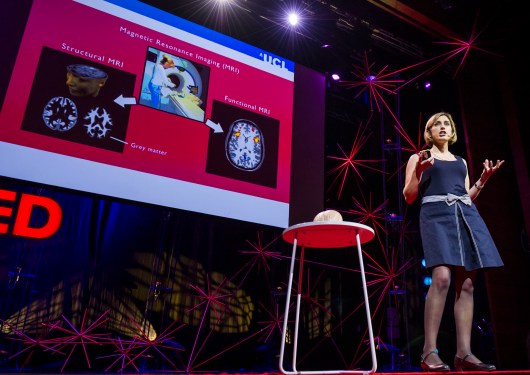“Fifteen years ago, it was widely assumed that the vast majority of brain development takes place in the first few years of life,” says professor Sarah-Jayne Blakemore, who heads up the Developmental Group at the UCL Institute of Cognitive Neuroscience. “Back then we didn’t have the ability to look inside the living human brain and track development across the lifespan.”
But that’s all changed. Blakemore’s work is now devoted to understanding how and when the human brain develops using technology that lets us do just that. And as it turns out, “It’s not all over in early childhood, but continues right throughout adolescence and into the twenties and thirties,” she says.
First, a definition of what she studies. “Adolescence is defined as the period of life that starts with the biological, hormonal and physical changes of puberty and ends at the age at which an individual attains a stable, independent role in society,” she says. The audience chuckles, and she acknowledges: “It can go on a long time.”
Brain-wise, the most dramatic change during those years happens to the prefrontal cortex, the area of the brain involved in high level cognitive functions such as decision-making, planning, social interaction and self-awareness. MRI studies show that this region undergoes quite dramatic change during adolescence. In fact, there’s a significant decline in the prefrontal cortex in adolescence. “That might sound bad, but it’s really important,” says Blakemore. We should think of it like pruning a rose bush, she advises. Just as you might prune away weak branches to ensure the remaining branches stay strong, the brain is finetuning itself.
Blakemore is particularly interested in the social brain, and she and her team are working to understand the network of brain regions we use to interact with other people. She shows a photograph of footballer Michael Owen, who has just failed to score a goal, in front of a crowd of crushed fans — every single one of them with hands on heads, faces contorted in identical pain. “The picture shows us how instinctive and automatic social responses are. Within a split second, everyone is doing the same thing with their arms and faces.” (Except the three guys in the back in the wrong section.)
It’s not just a funny picture; it also illustrates how good we are at reading other people. Yet analyzing both adolescents and adults showed up some interesting patterns. The brain area called the medial pre-frontal cortex is more active in adolescents when they make decisions than it is in adults — which suggests that adolescents really do use a different mental approach to make social decisions. She describe a test that shows that the ability to account for someone else’s perspective is still developing even in relatively late-stage adolescence. So, she says: “If you have an adolescent son or daughter and think they find it difficult to take direction, you’re right. They do!”
That, she argues, is why the demonization of adolescents is unfair. Their brains really are different. She recounts the story of a friend who said that the thing he noticed most about his teenage daughters was their level of embarrassment around him. “Before puberty he’d say ‘stop messing around, and I’ll sing you your favorite song.'” The girls would stop what they were doing and start behaving immediately. “After puberty, that became a threat. The very notion of their dad singing in public was enough to make them behave,” she says. The audience laughs knowingly.
Now Blakemore is trying to understand phenomena such as risk-taking, which activates the limbic system, hypersensitive in adolescents, while the prefrontal cortex, which moderates risk-taking, is still developing in adolescence. Science!
Her work is not only to justify the behavior of young people. Blakemore closes with an exhortation that we should think about the education of adolescents during this crucial period of brain growth. “40% of teenagers don’t have access to secondary-school education,” she says. “This is the period of life when the brain is particularly adaptive and malleable. It’s a fantastic opportunity for learning and creativity.”
Photos: James Duncan Davidson


Comments (12)
Pingback: “THEY LOOK NORMAL” – The Case For Puberty Blockers – THE GENDER COLLECTION
Pingback: Why Won’t My Teenager Get Out of Bed on Time?
Pingback: O que você sabe sobre bloqueadores de puberdade? – No Corpo Certo
Pingback: The Worth in the While of the Noisy Exercise of Existence: Me and Kool and the Gang’s Joanna | STERLING LYNCH
Pingback: Do You Want A Super Intelligent Brain? | prosperosworld.com
Pingback: Attachment Theory and Adolescence | Suzanne Zeedyk
Pingback: Day 65: A close-up look at the adolescent brain | 365 days of TED
Pingback: A close-up look at the adolescent brain: Sarah-Jayne Blakemore at TEDGlobal2012 « Good Stuff (for curious students and parents)